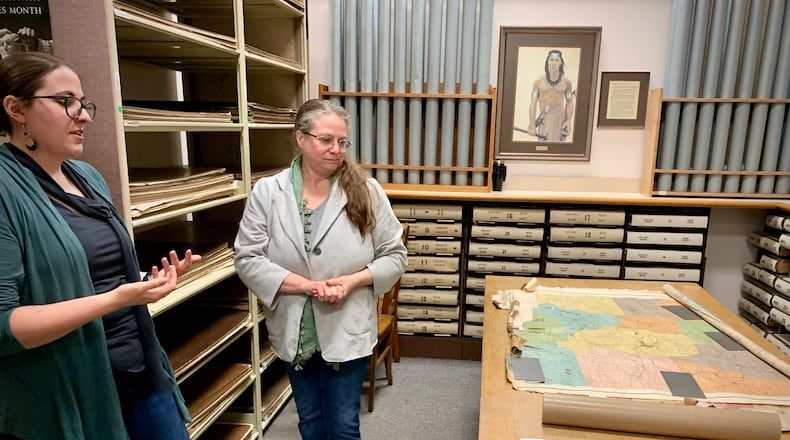• PHOTOS: 25 must-see images showing the destruction of the 1974 Xenia tornado
“It was interesting to hear just the variety of responses people had: how much warning they had, if any, what their initial response was, and how that impacted them long-term. For some of them, it still very much impacts even day-to-day life,” said Archives Public Outreach Director Mary McKinley.
Greene County Archives collected written stories from members of the community, as well as several donated photographs into a Community Tornado Digital Archive that will also be online and available alongside the video oral histories beginning today.
“Oral histories are all about capturing personal experience. And there is nothing that captures the personal experience better than seeing someone express it in their body language, in more than just what they’re saying,” McKinley said.
The events of the day, and even the landscape of the wreckage, are recurring characters in each account: a derailed train, a wrecked bowling alley, or a grocery store somehow left standing.
“You would hear a lot of stories that have commonalities,” McKinley said. “Even though the tornado destroyed a lot of local landmarks, there were these tornado-specific landmarks.”
People scrambled over the train to reunite with loved ones. The fire department, which normally navigated by buildings that were no longer there, had a hard time finding where the streets used to be.
“We also heard a lot of, especially with the married couples that were in different locations, how you couldn’t get into town that day if you were outside of town, because the National Guard was set up ... there’s total devastation,” said Greene County Archives Director Robin Heise.
Other stories are more bizarre.
“One woman shared with us that at her friend’s house... three of the four walls were gone from her bedroom, but on the fourth wall, her dresser was sitting there, and on top of the dresser was cash, and the cash was still there. It hadn’t moved.”
“Any other time, I would have done what comes naturally, closed the door to shut out the flashes of lightning, clamped my hands over my ears to deaden the sound of thunder. This time I didn't shut the door or my eyes. I stayed there on the floor and for a moment all was quiet. Then the window panes began to break. I could see glass, insulation, plaster and various objects whirling around in the hall, then came the awful sound of suction as if everything was being pulled from the ground. The vibration seemed to go on and on."
Greene County Archives also has damage reports from the Montgomery County Engineer’s Office, which came in to help assess the damage. Several reports simply say “house missing.” The Engineer’s Office used this language to document that they weren’t the ones who destroyed it with bulldozers in the following days.
“There are several photographs in our digital repository of folks who put signs out: ‘Do Not Doze’ or ‘Keep Basement,’ Heise said. “They had to put a sign on the front of their house to make sure that nobody just came in and wiped out the foundation.”
In the Greene County Public Library’s collection, Beulah Hawk described the devastation of the tornado as she hid in her Texas Drive house with her husband, Lewis. Beulah wrote that she was afraid of storms, but knew this was different.
“Any other time, I would have done what comes naturally, closed the door to shut out the flashes of lightning, clamped my hands over my ears to deaden the sound of thunder,” Hawk wrote. “This time I didn’t shut the door or my eyes. I stayed there on the floor and for a moment all was quiet. Then the window panes began to break. I could see glass, insulation, plaster and various objects whirling around in the hall, then came the awful sound of suction as if everything was being pulled from the ground. The vibration seemed to go on and on.”
Hawk’s story, alongside hundreds of others that have been collected over the last 50 years, is preserved in the Greene County Public Library’s collections, available online and at the Xenia branch of the library.
Librarians said that the work of documenting these stories has had a profound impact.
“When I moved to Xenia 18 years ago, I quickly realized how much the 1974 tornado impacted Xenia, but also the entire country,” said Greene County Library Adult and Technical Services Coordinator Tamar Kreke. “That was 32 years after the fact, and now, 50 years later, that deep scar remains. Of course, time has allowed the scar to fade, but it can still be seen in the preponderance of 1970s architecture and the way the path of the tornado has shaped the landscape of the city.”
For a couple of decades after the event, Xenians would refer to life as “before” and “after” the tornado, Kreke added.
“It’s important for the library and other local organizations to capture and share the stories as a significant chapter in the story of Xenia. Some of the people I interviewed for both the 40th and 50th anniversaries had told their “tornado story” so many times they needed little prompting from me. The trauma and devastation reverberates through time. The library, along with our city and county partners, has an important role in sharing each individual’s perspective as part of the greater narrative,” she said.
About the Author



